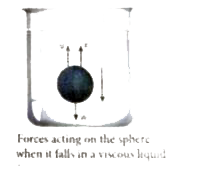Derive an expression for the terminal velocit of a sphere falling through a viscous liquid.Solution in Tamil
Expression for terminal velocity: Consider a sphere of radius r which falls freely through a highly viscous liquid of coefficient of viscosity η . Let the density of the material of the sphere be ρ and the density of the fluid be σ
Gravitational force acting on the sphere,

FG=mg=43πr3ρg (downward force )
Up thrust U=43πr3σg (upward force )
viscous force F=6πηrvt
At terminal velocity vt
Downward force upward force
FG=U−F⇒43πr3ρg−43σr3=6πηrvt
vt=29×r2(ρ−σ)ηg⇒vt∝r2
Here , it should be noted that the terminal speed of the sphere is directly proportional to the square of its radius. If sigma is greater than ρ , then the term (ρ−σ) becomes negative leading to a negative terminal vdocity.
Topper's Solved these Questions
- EXAMINATION QUESTION PAPER MARCH 2019Book:FULL MARKSChapter:EXAMINATION QUESTION PAPER MARCH 2019Exercise:PART-IV
Explore 10 Videos
- EXAMINATION QUESTION PAPER MARCH 2019Book:FULL MARKSChapter:EXAMINATION QUESTION PAPER MARCH 2019Exercise:PART-II
Explore 9 Videos
- EXAMINATION QUESTION PAPER - JUNE 2019Book:FULL MARKSChapter:EXAMINATION QUESTION PAPER - JUNE 2019Exercise:PART IV
Explore 10 Videos
- GRAVITATIONBook:FULL MARKSChapter:GRAVITATIONExercise:ADDITIONAL QUESTIONS SOLVED (Numerical Problems)
Explore 18 Videos
Similar Questions
The force F acting on a body moving in a circular path depends on mass of the body (m) velocity(v) and radius (r) of the circular path. Obtain the expression for the force by dimensional analysis method (k=1)
View SolutionWrite any two errors of systematic errors. Explain them.
View SolutionExplain in detail the triangle law of addition.
View SolutionA geo-stationary satellite is orbiting the Earth of a height of 6R above the surface of Earth R being the radius of the Earth calculate the time period of another satellite at a height of 2.5R from the surface of Earth.
View SolutionWhen a sphere falling in a viscous fluid attains a terminal velocity, then
View SolutionThe terminal velocity of a sphere moving through a viscous medium is :
View SolutionThe terminal velocity of a sphere of radius R, falling in a viscous fluid, is proportional to
View SolutionDerive the expression for the terminal velocity of a sphere moving in a high viscous fluid using stokes force.
View SolutionDerive an expression for the terminal velocit of a sphere falling through a viscous liquid.
View SolutionAn iron sphere of mass 20xx10^-3 kg falls through a viscous liquid with terminal velocity 0.5 ms^(-1) The terminal velocity (in ms^-1 ) of another iron sphere of mass 54 xx 10^2 kg is
View SolutionDerive the expression for the terminal velocity of a sphere moving in a high viscous fluid using stokes force.
View SolutionDerive the expression for the terminal velocity of a sphere moving in a high viscous fluid using stokes force.
View SolutionA lead sphere of mass m falls in a viscous liquid with a terminal velocity v0. Another lead sphere of mass S m through the same liquid will fall with the terminal velocity:
View SolutionDerive the expression for the terminal velocity of a sphere moving in a high viscous fluid using stokes force.
View SolutionWrite the formula of initial acceleration of sphere falling in a viscous medium and derive the formula of its terminal velocity from it .
View Solution